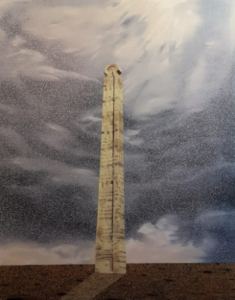Dr. Tenley Bick Responds to Racial Inequity through Research and Publications
 During her year as Scholar-in-Residence at Magazzino Italian Art in the mid-Hudson region of New York, Dr. Tenley Bick (Global Contemporary Art) watched as Italy became one of the first global hotspots in the COVID-19 pandemic, followed by New York in her immediate research environment. Urging for continued programming online at Magazzino during the crisis, which included pivoting her lecture series on Arte Povera’s global vision to an online platform, Dr. Bick also leveraged her experience in conducting virtual interviews with contemporary artists in Italy, including Afro-Italian artists Luigi Christopher Veggetti Kanku (b. 1979) and Jem Perucchini (b. 1995), to address the intersections between art, anti-racist activism, and race politics in pandemic-era Italy. Drawing upon these interviews and her new research into Italian museum programming, and with the support of her existing research in Italian colonialism, postcoloniality and contemporary art, Dr. Bick investigated the inattention to racial inequity in pandemic-era Italy and, through her essay, circulated a public call to Italian institutions to address this problem. Her essay, “‘My World Now Is Black in Color:’ Pandemic-Era Programming, Anti-Racist Activism, and Contemporary Art in Italy,” published in CAA International News (August 11, 2020), addresses the complex relations between monuments, racism, and national identity in short-form writing on contemporary art—shedding light on works finished during the pandemic and made in response to racial inequity in Italian culture.
During her year as Scholar-in-Residence at Magazzino Italian Art in the mid-Hudson region of New York, Dr. Tenley Bick (Global Contemporary Art) watched as Italy became one of the first global hotspots in the COVID-19 pandemic, followed by New York in her immediate research environment. Urging for continued programming online at Magazzino during the crisis, which included pivoting her lecture series on Arte Povera’s global vision to an online platform, Dr. Bick also leveraged her experience in conducting virtual interviews with contemporary artists in Italy, including Afro-Italian artists Luigi Christopher Veggetti Kanku (b. 1979) and Jem Perucchini (b. 1995), to address the intersections between art, anti-racist activism, and race politics in pandemic-era Italy. Drawing upon these interviews and her new research into Italian museum programming, and with the support of her existing research in Italian colonialism, postcoloniality and contemporary art, Dr. Bick investigated the inattention to racial inequity in pandemic-era Italy and, through her essay, circulated a public call to Italian institutions to address this problem. Her essay, “‘My World Now Is Black in Color:’ Pandemic-Era Programming, Anti-Racist Activism, and Contemporary Art in Italy,” published in CAA International News (August 11, 2020), addresses the complex relations between monuments, racism, and national identity in short-form writing on contemporary art—shedding light on works finished during the pandemic and made in response to racial inequity in Italian culture.
Content warning: This article includes references to sexual assault and anti-Black racist violence.
Read an excerpt of Dr. Bick’s essay below (full version: http://www.collegeart.org/news/2020/08/11/international-news-my-world-now-is-black-in-color-tenley-bick/). A related essay, also completed during her fellowship, “Ghosts for the Present: Countercultural Aesthetics and Postcoloniality for Contemporary Italy. The Work of Wu Ming 2 and Fare Ala” is in press in an edited volume forthcoming from Lexington Books: Does “la lutte continue”? The Global Afterlives of May ’68, edited by William Cloonan, Barry Faulk, Martin Munro, and Christian Weber (2020).
Excerpt:
“June 13, Milan. The 2006 monument to Italian journalist Indro Montanelli was found covered in red paint and tagged “razzista, stupratore”: racist, rapist. The intervention targeted the statue of Montanelli and the journalist’s past as a colonial soldier in East Africa. In 1935, Montanelli bought a twelve-year-old Eritrean girl, Destà, to serve as his wife under the practice of madamismo. Montanelli never apologized. The intervention ignited public debate in Italy on racism and public monuments, bringing the country popularly known for apathy toward its colonial and fascist histories, pervasive associated monuments and street names into renewed transatlantic debates on these topics. Four days prior, Italian-Somali writer Igiaba Scego, writing on anti-Black racism, Black Lives Matter, and monument debates in the United States and Europe in the Italian weekly Internazionale, made a call for Italy to confront the “uncomfortable traces of our past.” Citing an earlier intervention at the Montanelli monument in 2019, Scego noted the absent memorialization of Destà: “It would be nice if someone, whether a street artist or a municipality, dedicated a statue, a drawing, a memory to that distant child” (trans. Bick). Street artists and activists responded (Figs. 2–3). Cities did not. The Montanelli monument was cleaned and, by mayoral decision, remains in place…As Italy begins to address the presentness of its colonial past, the absence of Black Italian artists in Italy’s museums and galleries persists.”
.

